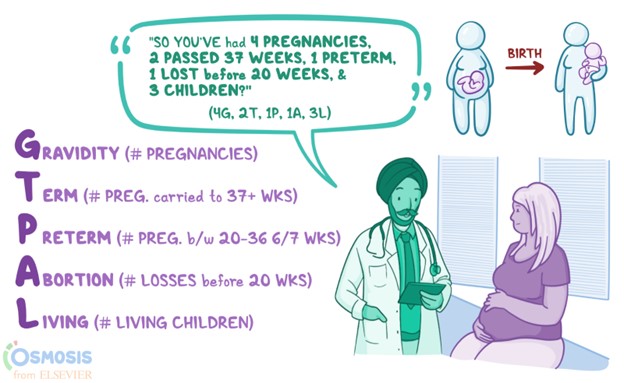A client who is 4 months pregnant is at the prenatal clinic for her initial visit. Her history reveals she has 7-year-old twins who were born at 34 weeks gestation, a 2-year-old son born at 39 weeks gestation, and a spontaneous abortion 1 year ago at 6 weeks gestation. Using the GTPAL method, the nurse would document her obstetric history as:
3-2-1-0-3
4-1-1-1-3
4-2-1-3-1
3-1-2-2-3
The Correct Answer is B
Choice A Reason: This option is incorrect because it underestimates the number of pregnancies (gravida) and overestimates the number of preterm births (preterm). The client has had four pregnancies (twins count as one pregnancy), not three. The client has had one preterm birth (the twins), not two.
Choice B Reason: This option is correct because it accurately reflects the client's obstetric history. GTPAL stands for Gravida, Term, Preterm, Abortions, and Living children. Gravida is the number of pregnancies a woman has had, regardless of outcome. Term is the number of pregnancies that ended at or beyond 37 weeks gestation. Preterm is the number of pregnancies that ended between 20 and 36 weeks gestation. Abortions are the number of pregnancies that ended before 20 weeks gestation, either spontaneously or induced. Living children are the number of children who are alive at present.
The client has had four pregnancies (gravida), one term birth (the son), one preterm birth (the twins), one abortion (the miscarriage), and three living children (the twins and the son).
Choice C Reason: This option is incorrect because it overestimates the number of preterm births (preterm) and underestimates the number of living children (living). The client has had one preterm birth (the twins), not two. The client has three living children (the twins and the son), not one.
Choice D Reason: This option is incorrect because it underestimates the number of pregnancies (gravida) and overestimates the number of abortions (abortions) and preterm births (preterm). The client has had four pregnancies (twins count as one pregnancy), not three. The client has had one abortion (the miscarriage), not two. The client has had one preterm birth (the twins), not two.

Nursing Test Bank
Naxlex Comprehensive Predictor Exams
Related Questions
Correct Answer is B
Explanation
Choice A Reason: This is incorrect because ambivalence is a mixed or contradictory feeling towards something or someone. It may occur in some women during pregnancy, especially if the pregnancy was unplanned or unwanted. However, it is not the most likely emotional response in the first trimester.
Choice B Reason: This is correct because emotional lability is a rapid and exaggerated change in mood or affect. It may occur in many women during pregnancy due to hormonal fluctuations, physical changes, and psychological stressors. Emotional lability may manifest as increased irritability, anxiety, sadness, or crying spells.
Choice C Reason: This is incorrect because introversion is a personality trait that indicates a preference for solitude and inward focus. It may be present in some women before or during pregnancy, but it is not an emotional response that is specific to the first trimester.
Choice D Reason: This is incorrect because acceptance is a positive attitude that indicates a willingness to embrace the reality of something or someone. It may develop in some women during pregnancy as they adjust to their new role and identity as mothers. However, it is not the most likely emotional response in the first trimester.
Correct Answer is ["2"]
Explanation
The correct answer is 2 mL. To calculate the volume to administer, the nurse should use the following formula:
Volume (mL) = Dose (units) / Concentration (units/mL)
Plugging in the given values, we get:
Volume (mL) = 1,200,000 units / 600,000 units/mL
Volume (mL) = 2 mL
Rounding to the nearest whole number, we get 2 mL.

Whether you are a student looking to ace your exams or a practicing nurse seeking to enhance your expertise , our nursing education contents will empower you with the confidence and competence to make a difference in the lives of patients and become a respected leader in the healthcare field.
Visit Naxlex, invest in your future and unlock endless possibilities with our unparalleled nursing education contents today
Report Wrong Answer on the Current Question
Do you disagree with the answer? If yes, what is your expected answer? Explain.
Kindly be descriptive with the issue you are facing.
